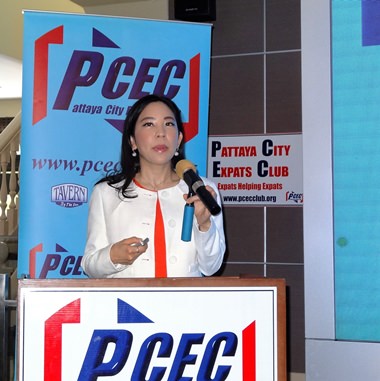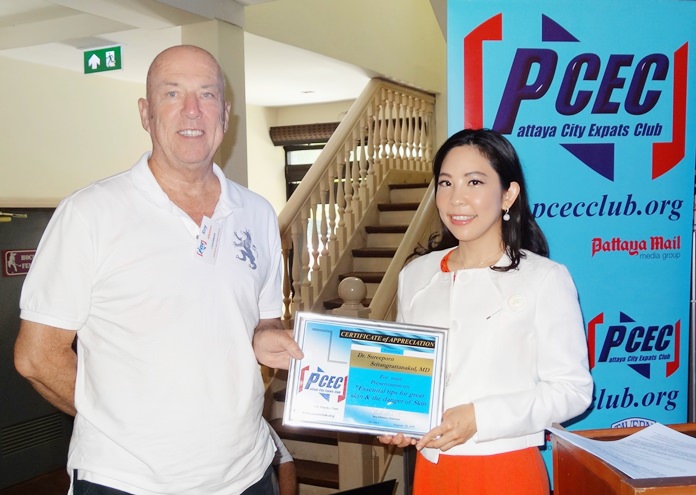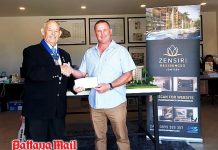Living in a tropical climate, fair skinned people need to be aware of the danger of skin cancer. Skin cancer and other skin diseases was the primary focus of the presentation given by Dr. Sureeporn Sritangrattanakul, MD, at the Sunday, August 21 meeting of the Pattaya City Expats Club (PCEC). Dr. Sureeporn is a Dermatologist from Bangkok Hospital Pattaya (BHP). She specializes in skin cancer medicine and various areas of cosmetic dermatology. In addition to her presentation, BHP nurses were available to provide free blood pressure and blood sugar checks for PCEC members and guests.

Dr. Sureeporn started the presentation by explaining the differences between chronological aging and biological aging. Chronological aging is just represented by the number of years a person has been alive while biological aging refers to the lifestyle factors one might have experienced. The lifestyle factors include diet, exercise and sleeping habits, to name a few.
Risks for disease and disability come under two categories: The first category is that which you cannot control, such as age, family history, race and ethnicity. The second category involves whether you smoke, what you eat, how much you move and your stress levels.
The doctor discussed some of the common skin problems including shingles. This disease is a viral infection that causes a painful rash, often described by patients as a rash with burning sensation. It can occur anywhere on your body, but mostly often appears as a single strip of blisters that wraps around either the left or the right side of the body. It is caused by the varicella-zoster virus, the same virus that causes chickenpox. While it isn’t life-threatening, it can be very painful. Vaccines can help reduce the risk of shingles, and early antiviral medication treatment can help shorten the infection and lessen the chances of complications.

Another common skin problem is Tinea Pedis (Athlete’s Foot). This is a fungal infection that usually begins between the toes or the bottom of the foot and occurs in people whose feet have become very sweaty while confined within tight fitting shoes. The symptoms include a burning sensation, with a scaly rash, that usually causes itching. Athlete’s foot is contagious and can be spread via contaminated floors, towels or other clothing. Therefore, to avoid the risk, shoes or sandals must be worn in public spaces.

Warts are caused by a viral infection, one of the HPVs (human papillomaviruses) that can be spread from person to person or through contact with a contaminated surface. Over-the-counter treatments include salicylic-acid preparations and a doctor may use a freezing procedure to remove warts.
Further, she said that probably the most common skin problem is sunburn. The sun gives off three wavelengths of ultraviolet light: UVA, UVB and UVC. UVC light does not usually reach Earth’s surface but UVA and UVB rays do. Sun damage is not always visible. Under the surface, ultraviolet light can alter your DNA, prematurely aging your skin. Over time, DNA damage can contribute to skin cancers, including the deadly melanoma. Sunburn relief involves keeping the skin hydrated. Creams or jell can take the sting out of the sunburn. Protection includes sunglasses (UV protective/wraparound), broad-brimmed hat, clothing (dark colors best), reapply sunscreen, SPF 30+ every 2 hours and after swimming.
Dr. Sureeporn talked the different types of skin cancer, including Squamous Cell Carcinoma, Basal Cell Carcinoma and Melanoma. Risk factors involve fair skin, history of sunburn, cumulative UV light exposure, living close to the equator or at high elevation, many or unusual moles, family history of melanoma and a weakened immune system. She displayed some of the warning signs of abnormal moles, such as asymmetrical, uneven border or variable color moles. She stressed the need to conduct self-examinations and to see a qualified dermatologist at least once a year and said a three-step, daily skin care is recommended, which includes keeping the skin clean, protecting it from the sun, and treating your particular skin needs.

“Healthy Living” charts were presented, with an emphasis on the danger of smoking. Also, becoming more physically active promotes a healthier heart, brain protection, better blood sugar control, stronger bones, improved sleep, better moods, fewer colds and arthritis relief.
An improved diet will also result in a healthier heart, reduced the risk of stroke, weight loss, and lessen the risk of diabetes. The doctor emphasized the devastating toll sugar has on your health. In fact, excessive sugar consumption may be the largest factor underlying obesity and chronic disease. She talked about sugar addiction, and the perpetual cycle: (1) You eat sugar; (2) Blood sugar levels spike; (3) Blood sugar levels fall rapidly; (4) Hunger and cravings begin, then the cycle repeats. She adds that to kick the habit, one has to start slowly and that “Rome was not built in a day.”
Use of water, a good night’s sleep and reduced stress were also discussed. Water composes 75% of your brain, carries nutrients and oxygen to your cells, regulates your body temperature, removes waste, cushions your joints, converts food to energy, protects vital organs, etc. Sleep might reduce weight gain, diabetes, heart disease and anxiety. Stress reduction/management was also emphasized.
The doctor’s final subject was the hospital’s Cosmetic Center. If the dream is to enhance your looks, is realistic and you have a favorable opinion from a qualified professional, why not follow your dream? Just remember to do your homework first. For filler injection procedures, seek a dermatologist who is trained, knows the types of fillers and all possible side effects. Then, accept realistic expectations.
After the presentation, MC Roy Albiston brought everyone up to date on upcoming events and called on Ira Wettenstein to conduct the Open Forum, where questions are asked and answered about Expat living in Thailand, especially Pattaya.
For more information on the PCEC’s many activities, visit their website at www.pcecclub.org.




